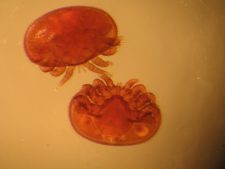Varroa Monitoring 2024
Fill out the Varroa Monitoring Survey here:
https://uoguelph.eu.qualtrics.com/jfe/form/SV_cT7FJQxzPFn5UBE
Download your Varroa Monitoring sheet here:
https://www.oahn.ca/wp-content/uploads/2023/09/Data-Sheet-for-2023-OVMC.pdf
The 2024 Ontario Varroa Monitoring Campaign – It’s as easy as one, two, three:
- Take part in the Varroa Monitoring Campaign, take control over your varroa mites and contribute to better control of varroa in Ontario.
- Sample your colonies for varroa mites. Instructions and reminders will be posted regularly.
- General instructions for sampling varroa:
- Sample at least one beeyard, ideally two or more
- Sample at ideally 5 colonies by two recommended methods
- Aim to do this at least every three weeks (we will provide prompts through general communications)
- Enter your data here: https://uoguelph.eu.qualtrics.com/jfe/form/SV_cT7FJQxzPFn5UBE
- Read about varroa biology, management and treatment options from credible sources of information, relevant to Ontario (see below).
See the “Now or Never”: Late Season Colony Management for Survival, Varroa Treatment Options and the Importance of Timing. Click here to download: https://www.oahn.ca/wp-content/uploads/2023/09/NoworNeverArticle.pdf
How to take a sample to monitor your varroa mites:
It is critical to use an approved Varroa mite monitoring method to track your Varroa mite levels. Waiting until you see visual signs of Varroa mites (e.g. mites on bees, deformed wings) is insufficient; by the time you are seeing these signs, irreversible damage has already been done. There are three approved monitoring methods:
Each of these methods has an economic treatment threshold that allows you to determine whether you need to apply a chemical treatment.
For more information see: http://www.omafra.gov.on.ca/english/food/inspection/bees/varroa-sampling.htm
Where is the information on how to manage and treat for Varroa in Ontario?
Chemical treatments should be applied promptly, once indicated by Varroa monitoring results (i.e. once the treatment threshold has been reached). Only chemical treatments that have been registered for use in honey bee hives in Ontario can be used. It is essential to read and follow the label instructions for all treatments. For information on registered treatments, as well as treatment thresholds and best practices for treatments and controlling Varroa.
For more information on treatment protocols and timing, watch this video from the Ontario Beekeepers’ Association Technology Transfer Program:
What is the Varroa Mite Awareness Campaign?
The goal of the 2024 Ontario Varroa Monitoring Campaign (OVMC) is to increase knowledge of Varroa mite monitoring and treatment in Ontario, and to gain information from all sectors of the beekeeping industry (hobbyist and commercial) about Varroa levels. The OAHN bee network’s goal is to provide high quality information that beekeepers can use to make the best possible treatment decisions.
Here’s the scoop:
Throughout the 2024 beekeeping season, beekeepers in Ontario will be asked to monitor the Varroa levels in their hives. After recording your Varroa levels, beekeepers can log their results and county to help us in this effort.
To fill out the 2024 Varroa Monitoring Survey, please click here:
https://uoguelph.eu.qualtrics.com/jfe/form/SV_cT7FJQxzPFn5UBE
All beekeepers – regardless of experience level or number of hives – are encouraged to contribute their Varroa data! The OVMC depends on the participation of as many Ontario beekeepers as possible. The more beekeepers we have monitoring for Varroa, the more data there will be on Varroa levels in Ontario and the better prepared we can be at dealing with them and maintaining the health of our colonies. The logging system is quick and easy to use, and is customized to commercial vs. smaller operations. Logging your levels can be done from anywhere you have cell phone reception. Beekeepers are encouraged to monitor and log their results multiple times throughout the season, including before and after treatment applications; this will allow you to assess the efficacy of the treatment.
 What is a Varroa mite?
What is a Varroa mite?
Varroa mites are parasites that live and feed on bees (see photo to the right). In addition to causing physical damage, they carry and transmit honey bee viruses by feeding, similar to ticks. However, Varroa mites are much bigger in relation to the bee’s body size when compared to ticks on humans. Virtually every honey bee colony in Ontario is infested with Varroa mites and the levels of Varroa are always increasing within the colony during the brood-rearing season.
Without proper management by beekeepers, Varroa mites can kill a colony, especially during the late fall and winter.
Why should I care about my Varroa mite levels in my colony?
Because bees co-mingle between colonies, within and between beeyards, Varroa mites can spread easily between colonies. Therefore, unmanaged Varroa mites will affect not only your own colonies, but neighbouring colonies as well. Protecting our colonies from Varroa infestation is a collaborative effort; every beekeeper in Ontario has a role to play! the more beekeepers monitor their own hives and take effective measures to effectively control their varroa levels on a regular basis the healthier the population of honey bees will be as a whole.
How can I help make this campaign a success?
Please share this page with any beekeepers, groups, or listservs you may be part of. If you are a beekeeping supply store, group etc and would like to get involved, please let us know by emailing oahn@uoguelph.ca.
Campaign organizers/collaborating organizations:
Varroa Mite Awareness Week is a collaborative effort between: Ontario Animal Health Network, Ontario Ministry of Agriculture, Food, and Rural Affairs (OMAFRA), University of Guelph, the Ontario Beekeeper’s Association, Tech Transfer Program, Niagara College Commercial Beekeeping Program, and the Animal Health Laboratory.
More resources:
For more resources for beekeepers from the OAHN Bee network, click HERE
Check back soon to find out where you can log your varroa levels.
How to monitor your Varroa levels:
Paul Kelly (University of Guelph, OAHN) and Paul Kozak (OMAFRA, OAHN) are here in 3 videos to help refresh you on Varroa monitoring techniques (see below)

